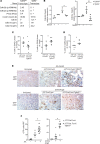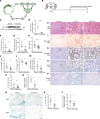Blocking cell cycle progression through CDK4/6 protects against chronic kidney disease
- PMID: 35730565
- PMCID: PMC9309053
- DOI: 10.1172/jci.insight.158754
Blocking cell cycle progression through CDK4/6 protects against chronic kidney disease
Abstract
Acute and chronic kidney injuries induce increased cell cycle progression in renal tubules. While increased cell cycle progression promotes repair after acute injury, the role of ongoing tubular cell cycle progression in chronic kidney disease is unknown. Two weeks after initiation of chronic kidney disease, we blocked cell cycle progression at G1/S phase by using an FDA-approved, selective inhibitor of CDK4/6. Blocking CDK4/6 improved renal function and reduced tubular injury and fibrosis in 2 murine models of chronic kidney disease. However, selective deletion of cyclin D1, which complexes with CDK4/6 to promote cell cycle progression, paradoxically increased tubular injury. Expression quantitative trait loci (eQTLs) for CCND1 (cyclin D1) and the CDK4/6 inhibitor CDKN2B were associated with eGFR in genome-wide association studies. Consistent with the preclinical studies, reduced expression of CDKN2B correlated with lower eGFR values, and higher levels of CCND1 correlated with higher eGFR values. CDK4/6 inhibition promoted tubular cell survival, in part, through a STAT3/IL-1β pathway and was dependent upon on its effects on the cell cycle. Our data challenge the paradigm that tubular cell cycle progression is beneficial in the context of chronic kidney injury. Unlike the reparative role of cell cycle progression following acute kidney injury, these data suggest that blocking cell cycle progression by inhibiting CDK4/6, but not cyclin D1, protects against chronic kidney injury.
Keywords: Cell cycle; Fibrosis; Nephrology.
Conflict of interest statement
Figures








References
Publication types
MeSH terms
Substances
Grants and funding
LinkOut - more resources
Full Text Sources
Medical
Molecular Biology Databases
Research Materials
Miscellaneous

